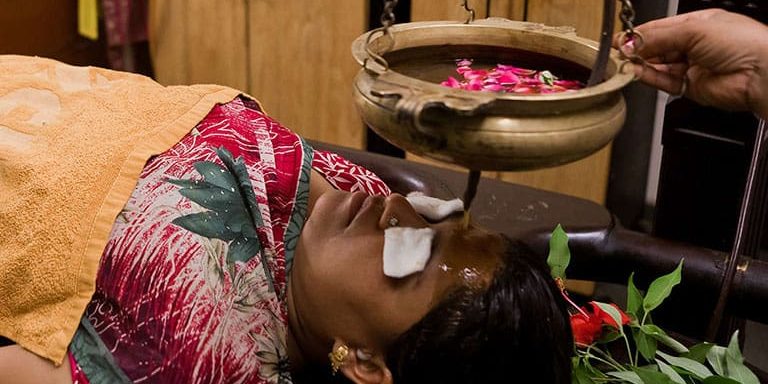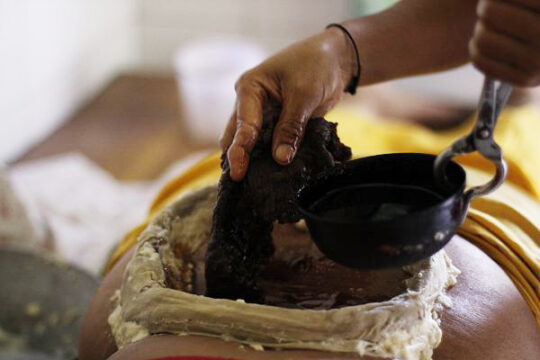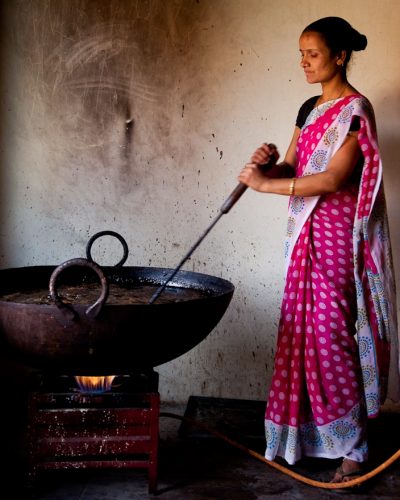Ayurvedic Medicine
Ayurveda is a traditional form of medicine which has a history in India stretching back more than two millennia. At Sambhavna, natural herbal remedies sourced from the community gardens are used alongside modern medicines to help alleviate symptoms of chronic conditions resulting from gas exposure.

Ayurvedic Medicine
Ayurveda is a traditional form of medicine which has a history in India stretching back more than two millennia. At Sambhavna, natural herbal remedies sourced from the community gardens are used alongside modern medicines to help alleviate symptoms of chronic conditions resulting from gas exposure.
Significant features of Ayurvedic healthcare at Sambhavna include the use of medicines described in standard texts, often produced on site, rather than factory-manufactured drugs.
There is a predominant use of herbal drugs over mineral preparations along with the use of modern investigative facilities and tools for objective assessment. There are two units in Ayurvedic care: general medicine and Panchakarma Chikitsa.
General Medicine
After a thorough examination based on Ayurvedic principles, people are treated from a range of 32 herbal powders, 12 plant sap extracts, 17 medicines of earthly and animal origin, and 53 herbal combinations.

Panchakarma Chikitsa
Panchakarma, literally meaning ‘five procedures’, detoxifies the body. It involves massage with medicated oils, medicated saunas, medicinal purging, hot fomentation and other procedures. It is particularly beneficial for chronic conditions.
Ayurvedic specialist, Dr Deshpande, first applied Ayurvedic medicine to the problems of gas exposure in 1985. He worked at Sambhavna when it began in 1996, facing familiar difficulties early on: ‘The first problem was that we had to create an awareness of herbal medicines. In the beginning people did not think so highly of Ayurvedic medicines. Then the patients who tried Ayurveda quickly found they were getting much and sustained relief.’
The clinic’s use of Ayurveda – as a complement to Western treatments – along with Panchakarma and Yoga, presents a direct challenge to the methods of treatment that have prevailed in Bhopal since the gas leak. These methods have largely been directed towards providing symptomatic relief without having any effect on the chronic disease process. Steroids, antibiotics and psychotropic drugs continue to be the mainstay of treatment in the hospitals and clinics run by the state government, the Bhopal Memorial Hospital Trust, and private doctors.

The continuing disaster has also been something of a windfall for drug manufacturers. A study carried out by Sambhavna in 1996 showed that a dozen transnational pharmaceutical companies in control of the drug market in Bhopal were the chief beneficiaries of the situation following the disaster.
Ayurveda, a more than 3000-year-old system of indigenous medicine, works on the principle of helping, with mostly herbal medicines, the body and mind heal itself. Ayurvedic toxicology (Agada tantra) mentions the vitiation of ‘doshas’ (humours) and loss of vitality (Ojas) as a result of poisons entering the body and the treatment recommended includes detoxification through Panchakarma, along with medicines for restoring vitality, immunity and the natural equilibrium of the body.
With the realisation of Ayurveda’s potential for healing Bhopal victims, the clinic has generated much interest among Ayurveda practitioners and researchers towards use of this ancient system in the healing of modern industrial diseases. Unlike pharmaceutical drugs, many of the Ayurvedic medicines can be prepared locally and inexpensively.
It is quite common to find people in Bhopal who say they have taken more than 10kg of pills and have had only temporary relief. There is substantial evidence that indiscriminate prescription of symptomatic drugs is compounding injuries caused by the disaster on a large scale.
Preparation of medicines
Sixty-four Ayurvedic medicines are manufactured in-house using herbs from our garden, locally collected or purchased herbs. The first herbal medicines prepared at the old clinic included: Churna (single herb and herbal mixture powders), Kwatha (decoctions), Taila (oils), Vati (tablets) and Lepa (poultice).
Since moving to our new location in 1996 and preparing and growing our own medicines, we now produce almost a hundred different medicines. These are manufactured on site, thanks to Glastonbury litterpicker volunteers in 2009, who raised enough for us to buy a special pill-making machine.
All medicines are provided free of cost. In dispensing medicines we take the utmost care to ensure that people are well informed about what they are taking, and where possible our community health workers follow up.

